
And when they do, things can go from bad to worse quickly.
Due to their small size, and issues and illnesses progress rapidly. Dehydration is no different.
That’s why it is imperative you know how to tell if your chinchilla is dehydrated.
Unfortunately, recognizing the signs of dehydration can be difficult.
But if you know what to look for, you’ll be able to spot this issue in time, and take steps to remedy it before it becomes serious.
Keep reading for 7 tips you can use to spot dehydration early and ensure your chinchilla suffers no harm.
Contents
- 1 How Can You Tell If A Chinchilla Is Dehydrated?
- 2 7 Tips For Spotting Chinchilla Dehydration
- 2.1 Tip 1: Understand Normal Chinchilla Fluid Intake
- 2.2 Tip 2: Inspect The Inside And Outside Of Your Chinchilla’s Ears
- 2.3 Tip 3: Use The Skin Pull Test To Check For Dehydration
- 2.4 Tip 4: Check If Your Chinchilla Is Lethargic Or Sleeping Too Much
- 2.5 Tip 5: Check Your Chinchilla’s Poop
- 2.6 Tip 6: Monitor How Much Your Chinchilla Is Urinating
- 2.7 Tip 7: Check To See If Your Chinchilla’s Cheek Bones Are More Prominent
- 3 Spotting Chinchilla Dehydration: Final Thoughts
How Can You Tell If A Chinchilla Is Dehydrated?
Chinchillas can become dehydrated without showing any signs or symptoms. To check if your chinchilla might be dehydrated, you can give its neck skin a slight pull and see how quickly it returns to its original position.
You can also monitor your chin’s water intake, to make sure it is getting enough hydration. Diarrhea is also an indicator of dehydration.
Don’t worry if you’re not completely sure how to do those things. We’re going to cover all of that below and give you a total of 7 tips for recognizing dehydration in your chinchilla.
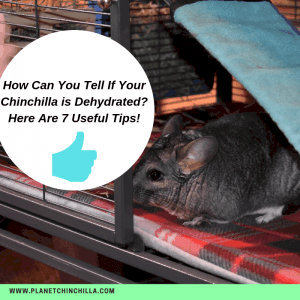
😕Adopting and caring for a new chinchilla can be intimidating and confusing. But it doesn’t have to be.
Be sure to check out my full digital eBook “Avoiding Critical Mistakes: Ultimate Chinchilla Care eBook” to get the best advice, tips, and tricks and supply recommendations to make adopting and caring for a chinchilla much more comfortable and easier to understand.
You can learn more about this eBook offer using the link directly below.
Learn more here:👉 Avoiding Critical Mistakes: Ultimate Chinchilla Care eBook Offer
7 Tips For Spotting Chinchilla Dehydration
As mentioned above, it is very possible that your chinchilla could become dehydrated and it is relatively difficult to tell when it happens.
One of the most telling ways to recognize dehydration with chinchillas is if you spot diarrhea instead of hard poop nuggets. This is almost always caused by decreased water intake or by offering your chinchilla the wrong food or treats.
It is also possible that your chinchilla is dehydrated, or potentially getting too hot, if you notice the inner ear turning red or blood vessels in the ear become visible.
And lastly, one more test you can complete is a simple skin pull test on your chinchilla’s neck. That said, I personally hate this method for checking if my chinchilla is dehydrated.
For one, it is not the most comfortable position to put your chinchilla. And second, I will be completely honest: I don’t really know at which speed the skin should return to the normal position, so I can’t really tell if it is doing so too slowly.
This is why I go with the easiest method of them all. I simply monitor how much water my chinchilla is taking in, ensure that she does not get too hot, and that her poop is not diarrhea.
If those criteria are being met, dehydration is not something you need to worry about.
Now that we know some of the basics, I want to dive into my 7 tips for recognizing and helping with dehydration in your chinchilla.
Tip 1: Understand Normal Chinchilla Fluid Intake
Picture yourself as a concerned parent for your own children. In order to recognize that something is off with your children, you first need to be aware of what’s normal and typical behavior.
The same applies to owning a chinchilla.
This all begins with understanding how much water your chinchilla consumes typically. For my chinchilla, she will drink one full water bottle with a nozzle dripper roughly once per week. This is the bottle I use.
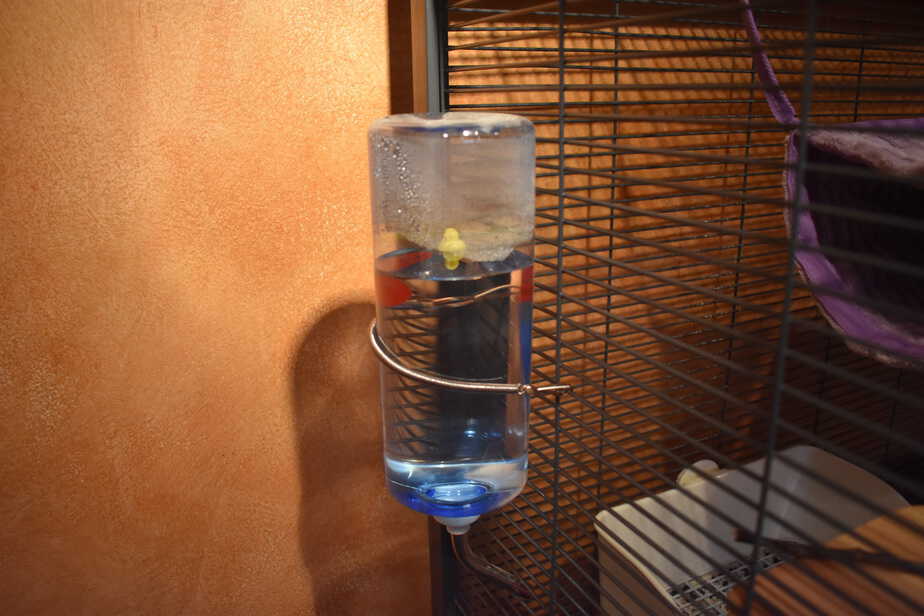
However, be aware that water bottles come in different sizes, so this may not apply to you. You’ll need to figure out what is normal for your chin. It’s not that hard.
I know her consumption down to a science, because, I wash and rinse her water bottle during my regular cage cleanings.
It’s like clockwork. Almost every Sunday when I clean her cage, her water bottle is getting close to being empty.
This helps you to begin understanding the healthy behaviors your chinchilla typically displays.
Don’t worry too much about this, if it seems complicated. A lot of this learning curve just happens as you go through the process, like anything in life.
Sure, I was on Google nearly every day asking questions and learning about my chinchilla in the beginning, but now I’m here hoping to help all of you.
It’s easy, in all honesty, and only gets easier as you go. However, at the end of the day, it was owning a chinchilla and learning the hard way that’s really made me the owner I am today.
Now, assuming you do understand your chinchilla’s normal behavior, it’s time to move on to the next methods you can use to help determine if your chinchilla may be dehydrated. These will involve more visual inspections you can perform to check your chinchilla for dehydration.
Tip 2: Inspect The Inside And Outside Of Your Chinchilla’s Ears
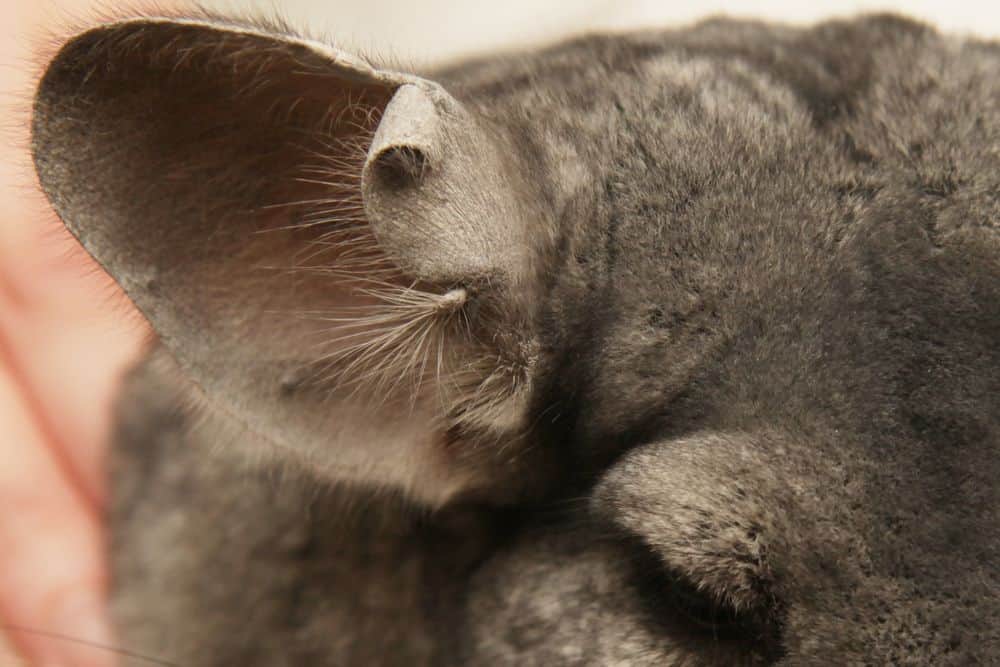
This inspection is essential for more than just checking your chinchilla’s fluid intakes. You also use it to check or overheating, which can be fatal as well.
Your chinchilla’s ears do not actually have a direct connection to dehydration, but they do indicate trouble that you need to remedy by giving your pet cold fluids.
Chinchillas overheat very easily. Overheating can cause heatstroke if it goes unnoticed. They overheat so easily due to their dense fur and their inability to sweat or release heat in the same way as other mammals.
Instead, your chinchilla releases heat through its ears. When your chinchilla is near overheating, you will notice the veins in its ears begin to dilate and become visible.
Depending on the color of your chinchilla, you can notice this on the inside and outside of your chinchilla’s ears. Dark-colored or ebony chinchillas will likely require you to brush the fur out of the way, or to check the inner ears.
Light-colored chinchillas are much easier. If your chinchilla is a light color, you should be able to notice your chinchilla’s ears turning red on both the exterior and interior of their ear.
Again, this indicates overheating. To fix this problem, you need to cool down your chinchilla.
To do this, you need to get it to a room that has colder temperatures. If you haven’t read my post about proper chinchilla temperatures, you need to.
Additionally, your chinchilla needs to drink water. You can also use a cold rag and dab its ears to help cool them down.
As stated before, red ears don’t directly relate to dehydration. However, dehydration is directly related to the need for more water and fluids.
If you notice your chinchilla potentially on the verge of overheating, you need to give it fluids or dehydration could occur, ultimately causing death.
Simply remember to keep your chinchilla rooms with the in proper temperature, to always have water available, to not make your pet overexert itself during playtime.
Following these steps should make you a pro at tip #2 and have you one step closer to avoiding dehydration and potential overheating.
Tip 3: Use The Skin Pull Test To Check For Dehydration
You may be familiar with this tip, because it is a test we often even perform on ourselves. You basically pull on a bit of sin and observe how quickly it returns to its original state.
To do this, comb or pull back the hair on your chinchilla’s neck. You should use your thumb and index finger to perform this test.
In addition, you want to do so calmly and gently, to avoid startling your chinchilla or causing a fur slip. This is especially true if there is a chance that your chinchilla is not feeling well or could potentially be coming down with an illness.
After pulling the skin on the neck gently in an upward direction, release the skin. If it is slow to return to its normal resting position, your chinchilla is dehydrated and needs fluids. You may want to consider calling a vet, too.
However, if your chinchilla’s skin returns to its normal position quickly (i.e. the way it usually does), your chinchilla is likely not dehydrated, and you can wipe this off your worry list.
However, as always continue to monitor and care for your chinchilla the same way you would for anyone in your family.
Tip 4: Check If Your Chinchilla Is Lethargic Or Sleeping Too Much
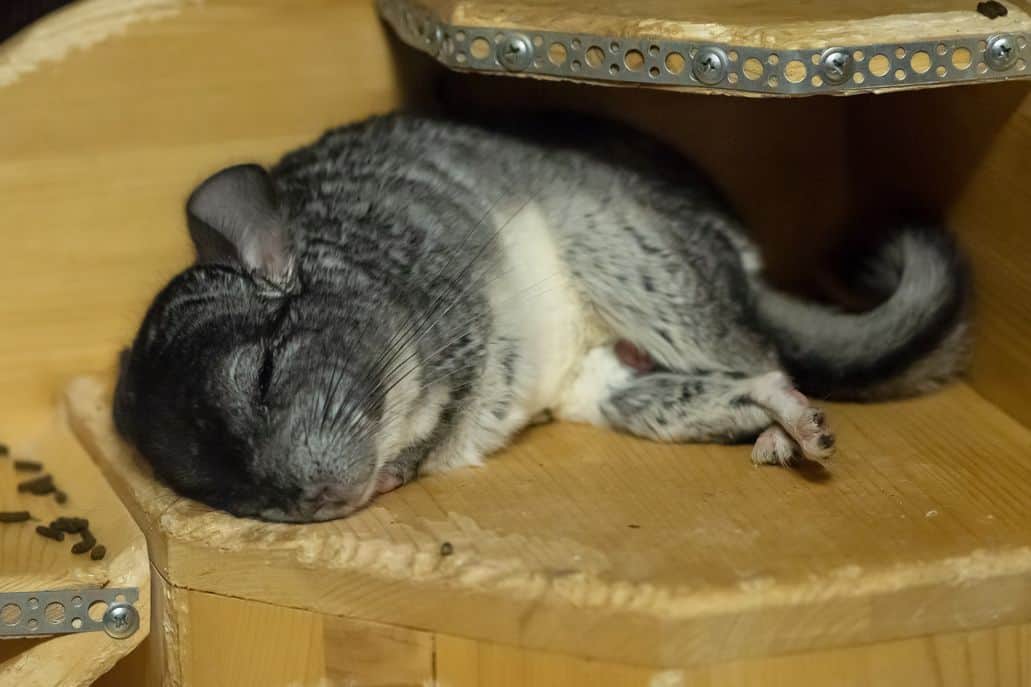
Another telling sign that your chinchilla may be dehydrated is the behavior it displays. We all know how chinchillas usually act. They love climbing and jumping on nearly everything they can.
For a better understanding of these topics, start by reading my post discussing if chinchillas climb. You can also read my post discussing if chinchillas jump.
They will help explain what to beware of, how to keep your chin safe, and what to expect.
If your chinchilla is suddenly not acting like itself, this could indicate dehydration or another illness. Lethargic behavior and abnormal amounts of sleep can indicate your chinchilla is dehydrated or coming down with another illness.
If your chinchilla is in this state of mind and frame of body, I highly recommend trying to get it to drink water and seeing a vet as soon as possible.
With small pets like chinchillas, when they do fall ill, it can get worse quickly. It’s always important to remain proactive with your care and actively monitor your chinchilla to make sure it is happy and healthy.
Tip 5: Check Your Chinchilla’s Poop
Chinchillas poop all the time, if you were not yet aware. Additionally, chinchilla poop is always about the same size, shape, and color. To help you out, I have a post that details how often chinchillas poop, plus everything else you need to know about their pooping habits.
This makes spotting illnesses in your chinchilla, or something out of the ordinarily, easy to do. If your chinchilla’s poop is getting smaller, less frequent, or potentially even soft, it can be a sure-fire sign that your chinchilla is dehydrated.
This is also another example of when you should probably call your vet. You need to ensure your chinchilla doesn’t have something worse than dehydration. It’s better to be safe than sorry in these circumstances.
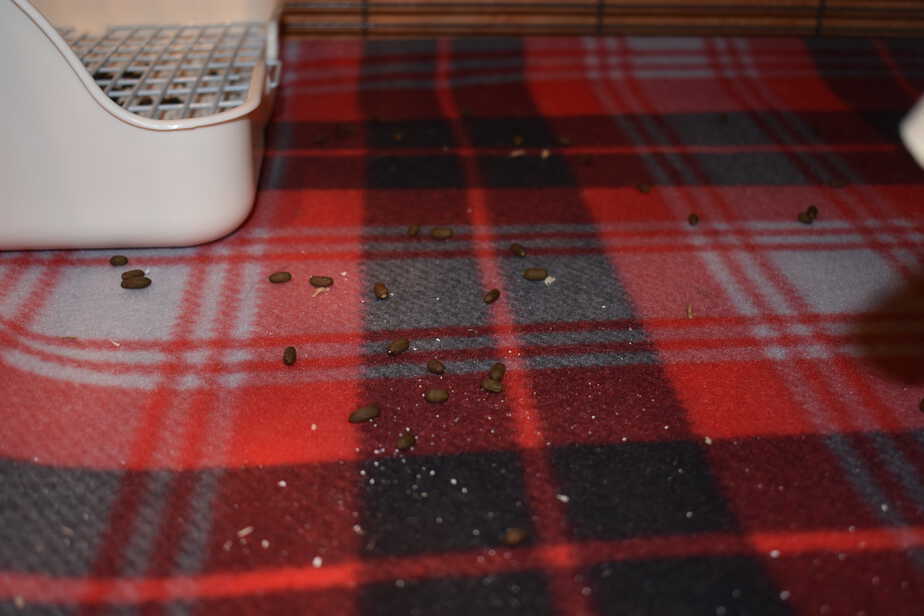
Tip 6: Monitor How Much Your Chinchilla Is Urinating
Up next on our to-do list is keeping diligent tracking of your chinchilla’s urine. If you are currently using bedding in your chinchilla’s cage, this is going to be very tough to do.
It’s still doable, if you know the corner of the cage where your chinchilla typically urinates. But there is a much easier way that makes clean-up easier, too. And it saves money in the long run.
These are all reasons why I always recommend using custom fleece liners for you cage.
- Designed specifically for Critter Nation Cage
- Includes: Two large pan liners (one with a notch/cut-out for the ramp opening, Two small shelf liners and three ramp covers
- Available in various designs
Those liners I linked to are specifically designed for the Critter Nation 2 chinchilla cage, which is the cage I use and easily the best cage for chinchillas, period.
Not only is the fleece better on your chinchilla’s feet, but as mentioned, it’s also easier to clean and cheaper in the long run (since you no longer have to keep buying new wood shavings).
More importantly for our purposes here, it makes noticing and tracking your chinchilla’s urine easy. You see, you need to wash the fleece liners in cold water at least once a week.
Before washing them, it’s obvious where your chinchilla has urinated. If you are hesitant about purchasing these fleece liners, I highly recommend reading another blog post I have.
It details if the fleece is safe for chinchillas and explains in more detail why I’m so in love with these cut-to-fit liners, as opposed to traditional chinchilla bedding, like aspen shavings.
For my chinchilla, I’m actually trying to litter pan train her at the moment. Nonetheless, when she doesn’t use the pan, I can easily see the wet spots where she has urinated.
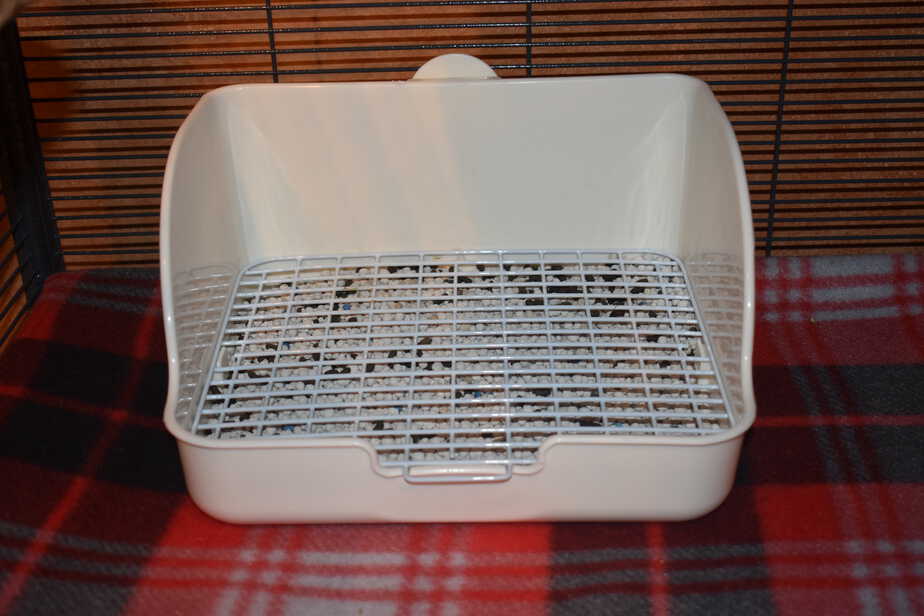
If your chinchilla is suddenly not urinating at the same frequency as usual, this can be a fast and sure indicator that it is dehydrated.
Try to get your chinchilla drinking cold water and call your vet if the problem continues.
Tip 7: Check To See If Your Chinchilla’s Cheek Bones Are More Prominent
The final tip I have for you is to know your chinchilla well enough to recognize changes in its physical appearance. It is common for a chinchilla’s cheekbones to become more prominent when it is dehydrated.
If you do notice this taking place, use the same solution we have been discussing this entire post. Attempt to get your chinchilla consuming fluids and make a call and schedule a visit with your vet.
You should also clean the water bottle and check for blockages, in case that is preventing your chin from drinking enough water. Make sure to check the temperature of the room as well, and adjust it if needed.
Dehydration can be dangerous. Remember, it’s always better to be safe than sorry, if you want to be an ethical chinchilla owner.
Spotting Chinchilla Dehydration: Final Thoughts
Owning a chinchilla is easy in my opinion. It requires love and dedication, but not much time, effort or money, in comparison to most other pets.
What will help you most is building a bond with your chin and gaining an understanding of its normal behaviors. Some of this will come naturally, and some of it will require research and checking on Google, just like you are now.
How you learn these critical tips about your chinchilla’s health, happiness and lifestyle is not really important. What is important is taking the time to bond and to learn about chinchilla and what s best for it.
As for learning to tell if a chinchilla is dehydrated, you want to check urine, poop, water bottle levels, skin and ears, and watch for abnormal behavior. That’s the fastest and most straightforward way to explain it.
Chili and I wish you the best of luck with your new chinchilla and the journey you have ahead of you.
Now we want to hear from you!
Has your chinchilla been dehydrated in the past?
How did you recognize dehydration and what did you do to solve the issue?
Be sure to share those stories, thoughts, and concerns by dropping a comment below.
As always, Chili and I appreciate you stopping by and reading today and we will see you again next time!

Leave a Reply